User Manual
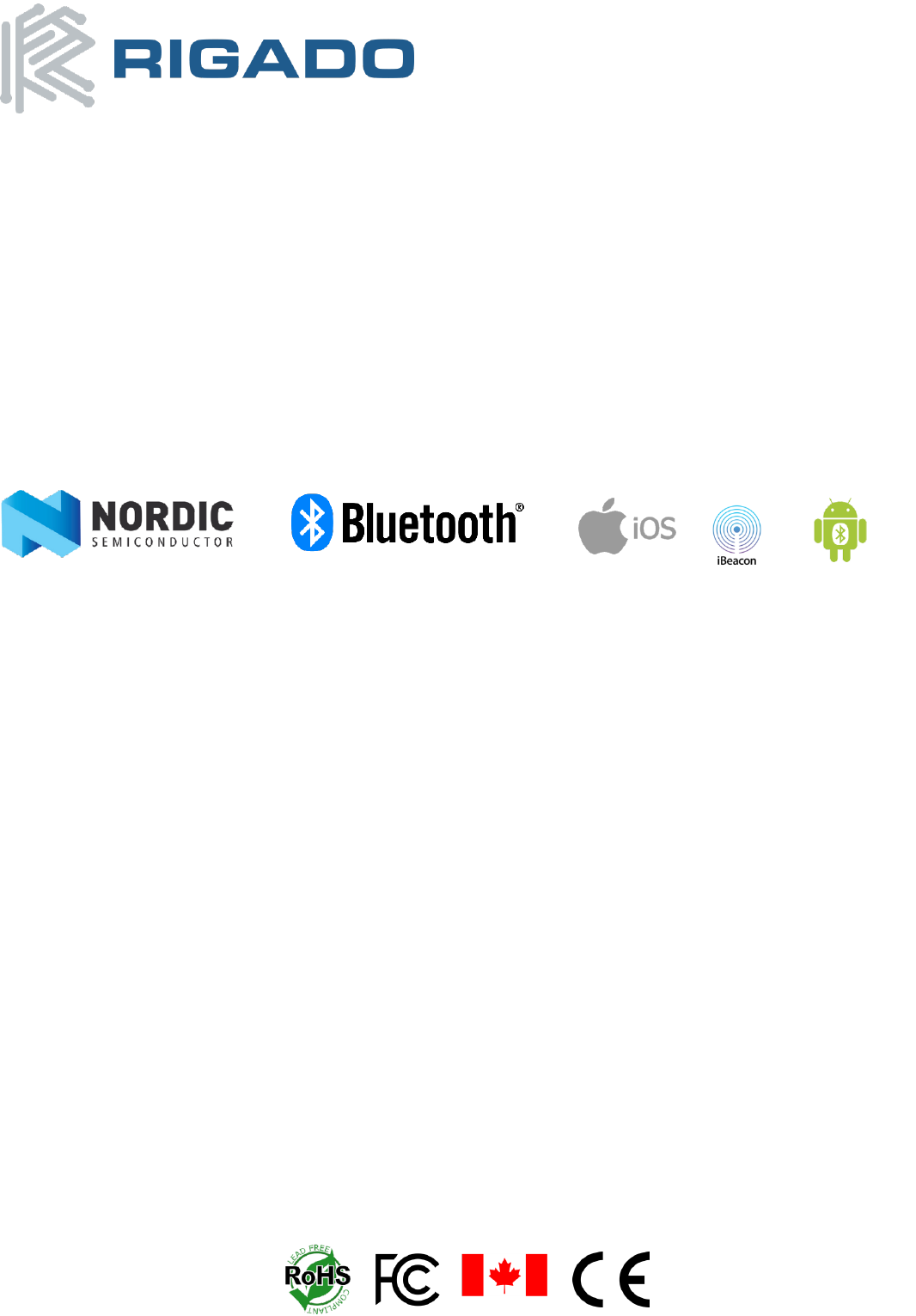
BMD-330-DS V0.9 Page 1 of 24
BMD-330 Module for Bluetooth 5 LE
The BMD-330 from Rigado is a powerful, highly flexible, ultra-low power Bluetooth Smart
module based on the nRF52810 SoC from Nordic Semiconductor. With an ARM®
Cortex™ M4 CPU, embedded 2.4GHz transceiver, and integrated antenna, it provides a
complete RF solution with no additional RF design, allowing faster time to market.
Providing full use of the nRF52810’s capabilities and peripherals, the BMD-330 can
power demanding applications, while simplifying designs and reducing BOM costs. With
an internal DC-DC converter and intelligent power control, the BMD-330 provides class-
leading power efficiency, enabling ultra-low power sensitive applications. Regulatory
pre-approvals reduce the burden to enter the market. As a drop in replacement for the
BMD-300/301, the BMD-330 completes Rigado’s BMD-300 Series lineup with an
optimized peripheral set that is attractive for a wide range of cost-sensitive applications.
1. Features
• Based on the Nordic nRF52810 SoC
• Complete RF solution with integrated antenna
• Integrated DC-DC converter
• No external components required
• ARM® Cortex™-M4 32-bit processor
• Serial Wire Debug (SWD)
• Nordic SoftDevice ready
• Over-the-Air (OTA) firmware updates
• 192kB embedded flash memory
• 24kB RAM
• 32 General Purpose I/O Pins
• 12-bit/200KSPS ADC
• -40C to +85C Temperature Range
• FCC: 2AA9B09 (Pending)
• SPI Master/Slave (8 Mbps)
• General purpose comparator
• Temperature sensor
• Random Number Generator
• 2-wire serial Master/Slave (I2C compatible)
• UART (w/ CTS/RTS and DMA)
• 20 channel CPU independent Programmable
Peripheral Interconnect (PPI)
• Quadrature Demodulator (QDEC)
• 128-bit AES HW encryption
• 3 x 32bit, 2 x 24bit Real Timer Counters (RTC)
• Dimensions: 14 x 9.8 x 1.9mm
• IC: 12208A-09 (Pending)
2. Applications
• Climate Control
• Lighting Products
• Safety and Security
• Home Appliances
• Access Control
• Internet of Things (IoT)
• Home Health care
• Advanced Remote Controls
• Smart Energy Management
• Low-Power Sensors
• Beacons– iBeacon™,
AltBeacon, Eddystone, etc.
• Environmental Monitoring
• Hotel Automation
• Office Automation
• Wearables
Industry Canada
User Manual
Product Name: BMD-330
Brand: RIGADO
Model:BMD-330
Manufacture: Rigado, Inc.
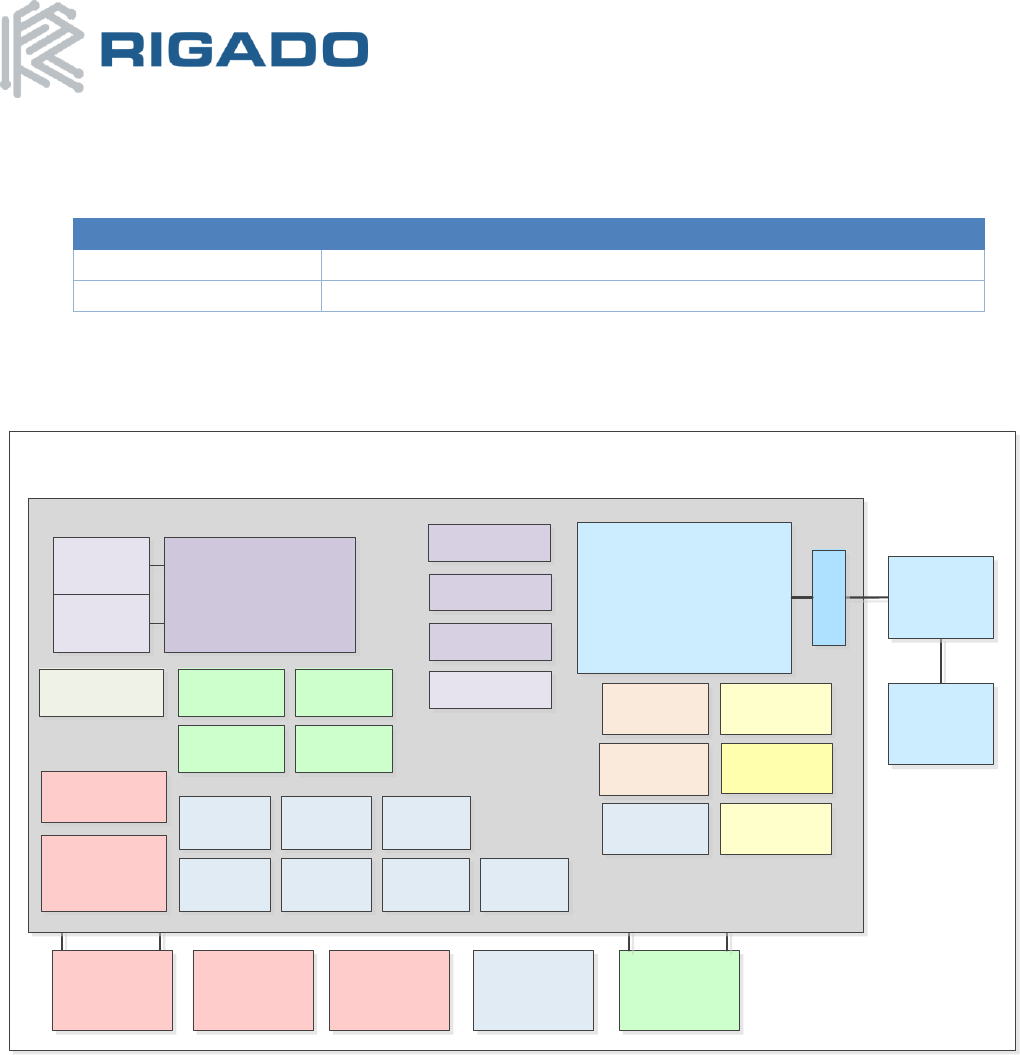
BMD-330 Module Datasheet
Bluetooth 5
September 13, 2017
BMD-330-DS V0.9 Page 2 of 24
3. Ordering Information
Email modules@rigado.com for quotes and ordering or visit http://www.rigado.com/BMD-330
Part Number Description
BMD-330-A-R BMD-330 module, Rev A, Tape & Reel, 1000 piece multiples
BMD-330-EVAL BMD-330 Evaluation Kit with Segger J-Link programmer
Table 1 – Ordering Part Numbers
4. Block Diagram
BMD-330 Module
32 MHz
Crystal
nRF52810
192kB
Flash
DC-DC
Inductor
Decoupling
Capacitors
Bulk
Capacitors
2.4GHz Radio
Multi-protocol
TWI
Master
SPI
Master
SPI Slave
DC/DC Buck
Regulator
Core LDO
24kB RAM
8-ch 12-bit
ADC
UART Quadrature
Decoder
SWD Debug &
Programming Temperature
Sensor
Cloc k
Management
Watchdog
Timer
Random Number
Gen
Timer x3
Accel Address
Resolver
AES CCM Mode
Encryption
AES ECB
Real Time
Counter x2
GPIO Task
Event Blocks
Programmable
Peripheral
Interconnect
ARM Cortex-M4
@ 64MHz Matching
Network
Antenna
GPIO x32
(Analog x8)
TWI Slave 4ch P WM PDM
General
Purpose
Comparator
Balun
Figure 1 – Block Diagram

BMD-330 Module Datasheet
Bluetooth 5
September 13, 2017
BMD-330-DS V0.9 Preliminary – Subject to Change Page 3 of 24
Table of Contents
1. FEATURES ...............................................................................................................................................................................1
2. APPLICATIONS ........................................................................................................................................................................1
3. ORDERING INFORMATION......................................................................................................................................................2
4. BLOCK DIAGRAM ....................................................................................................................................................................2
5. QUICK SPECIFICATIONS ..........................................................................................................................................................4
6. PIN DESCRIPTIONS .................................................................................................................................................................5
7. ELECTRICAL SPECIFICATIONS ..................................................................................................................................................7
7.1 ABSOLUTE MAXIMUM RATINGS ..................................................................................................................................................... 7
7.2 OPERATING CONDITIONS .............................................................................................................................................................. 7
7.3 GENERAL PURPOSE I/O ............................................................................................................................................................... 7
7.4 MODULE RESET ....................................................................................................................................................................... 8
7.5 DEBUG & PROGRAMMING ............................................................................................................................................................ 8
7.6 CLOCKS ................................................................................................................................................................................... 8
8. FIRMWARE .............................................................................................................................................................................9
8.1 FACTORY IMAGE ........................................................................................................................................................................ 9
8.2 SOFTDEVICES ............................................................................................................................................................................ 9
8.2.1 S132 ................................................................................................................................................................................... 9
8.3 MAC ADDRESS INFO ................................................................................................................................................................ 10
9. MECHANICAL DATA .............................................................................................................................................................. 11
9.1 MECHANICAL DIMENSIONS ......................................................................................................................................................... 11
9.2 RECOMMENDED PCB LAND PADS ................................................................................................................................................. 12
10. MODULE MARKING .............................................................................................................................................................. 12
11. RF DESIGN NOTES ................................................................................................................................................................. 13
11.1 RECOMMENDED RF LAYOUT & GROUND PLANE ............................................................................................................................... 13
11.1.1 BMD-300 .......................................................................................................................................................................... 13
11.2 MECHANICAL ENCLOSURE........................................................................................................................................................... 13
11.3 ANTENNA PATTERNS ................................................................................................................................................................. 14
12. EVALUATION BOARDS .......................................................................................................................................................... 16
13. SOLUTION SERVICES ............................................................................................................................................................. 16
14. BLUETOOTH QUALIFICATION ................................................................................................................................................ 17
15. REGULATORY STATEMENTS .................................................................................................................................................. 17
15.1 FCC STATEMENT: .................................................................................................................................................................... 17
15.2 FCC IMPORTANT NOTES ............................................................................................................................................................ 17
15.3 IC STATEMENT: ....................................................................................................................................................................... 19
15.4 IC IMPORTANT NOTES ............................................................................................................................................................... 19
15.5 CE REGULATORY ...................................................................................................................................................................... 20
15.6 AUSTRALIA / NEW ZEALAND ........................................................................................................................................................ 20
16. SOLDER REFLOW TEMPERATURE-TIME PROFILE ................................................................................................................... 21
16.1 MOISTURE SENSITIVITY LEVEL ...................................................................................................................................................... 21
17. PACKAGING AND LABELING.................................................................................................................................................. 21
17.1 CARRIER TAPE DIMENSIONS ........................................................................................................................................................ 21
17.2 REEL PACKAGING ..................................................................................................................................................................... 22
17.3 PACKAGING LABEL .................................................................................................................................................................... 22
18. CAUTIONS ............................................................................................................................................................................ 23
19. LIFE SUPPORT POLICY ........................................................................................................................................................... 23
20. DOCUMENT HISTORY ........................................................................................................................................................... 24
21. RELATED DOCUMENTS ......................................................................................................................................................... 24
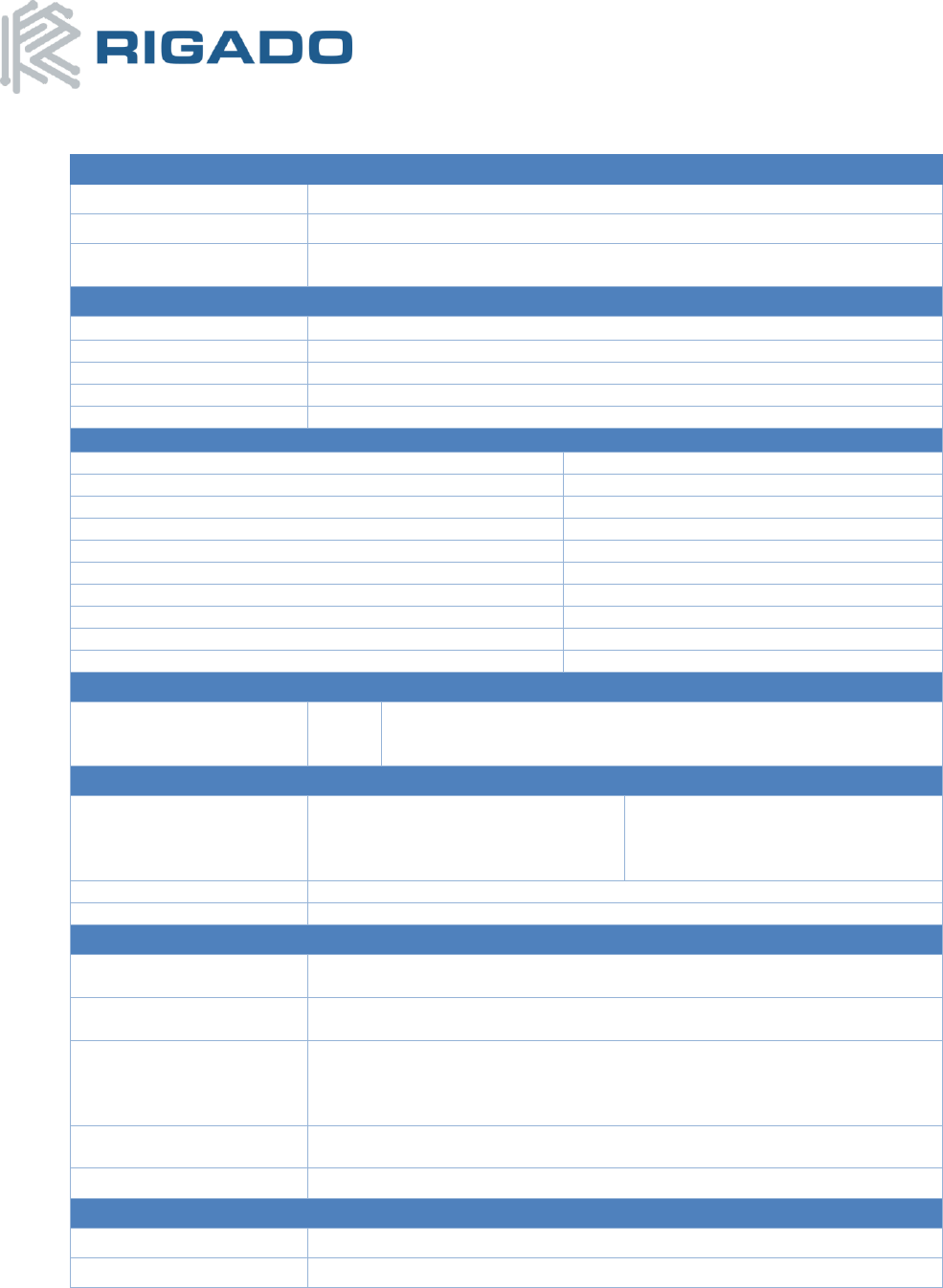
BMD-330 Module Datasheet
Bluetooth 5
September 13, 2017
BMD-330-DS V0.9 Preliminary – Subject to Change Page 4 of 24
5. Quick Specifications
Bluetooth
Version 5.0 (Bluetooth Smart) Concurrent Central & Peripheral (S132)
Security AES-128
LE connections Concurrent central, observer, peripheral, and broadcaster roles with multiple
concurrent connections along with one Observer and one Broadcaster (S132)
Radio
Frequency
Modulations GFSK at 1 Mbps, 2 Mbps data rates
Transmit power +4 dBm
Receiver sensitivity -96 dBm (BLE mode)
Antenna Integrated
Current Consumption
TX only @ +4 dBm, 0 dBm @ 3V, DCDC enabled 7.0 mA, 4.6 mA
TX only @ +4 dBm, 0 dBm 15.4 mA, 10.1 mA
RX only @ 1 Mbps @ 3V, DCDC enabled 4.6 mA
RX only @ 1 Mbps 10.0 mA
RX only @ 2 Mbps @ 3V, DCDC enabled 5.8 mA
RX only @ 2 Mbps 11.2 mA
CPU @ 64MHz from flash, from RAM 4.0 mA, 3.8 mA
CPU @ 64MHz from flash, from RAM @ 3V, DCDC 2.4 mA, 2.1 mA
System Off, On 0.3 µA, 0.6 µA
Additional current for RAM retention 30 nA / 4KB block
Dimensions
BMD-330
Length
Width
Height
14.0 mm ± 0.3mm
9.8 mm ± 0.3mm
1.9 mm ± 0.1mm
Hardware
Interfaces
SPI Master/Slave
UART
Two-Wire Master/Slave (I2C)
GPIO x 32
I2S
PWM
PDM
ADC
Power supply 1.7V to 3.6V
Temperature Range -40C to +85°C
Certifications
FCC FCC part 15 modular certification (Pending)
FCC ID: 2AA9B09
IC Industry Canada RSS-210 modular certification
IC: 12208A-09
CE
EN 60950-1: A2:2013 3.1 (a): Health and Safety of the User
EN 301 489-1 V2.1.1 & 3.1 (b): Electromagnetic Compatibility
EN 301 489-17 V3.1.1
EN 300 328 V2.1.1 3.2: Effective use of spectrum allocated
Australia / New Zealand AS/NZS 4268 :2012+AMDT 1:2013, Radio equipment and systems – Short range devices
(Pending)
Bluetooth RF-PHY Component (Pending)
Export
ECCN 5A992.C, Exception 742.15(b)(1)
HTS 8473.30.1180
Table 2 – Quick Specifications
2402-2480MHz
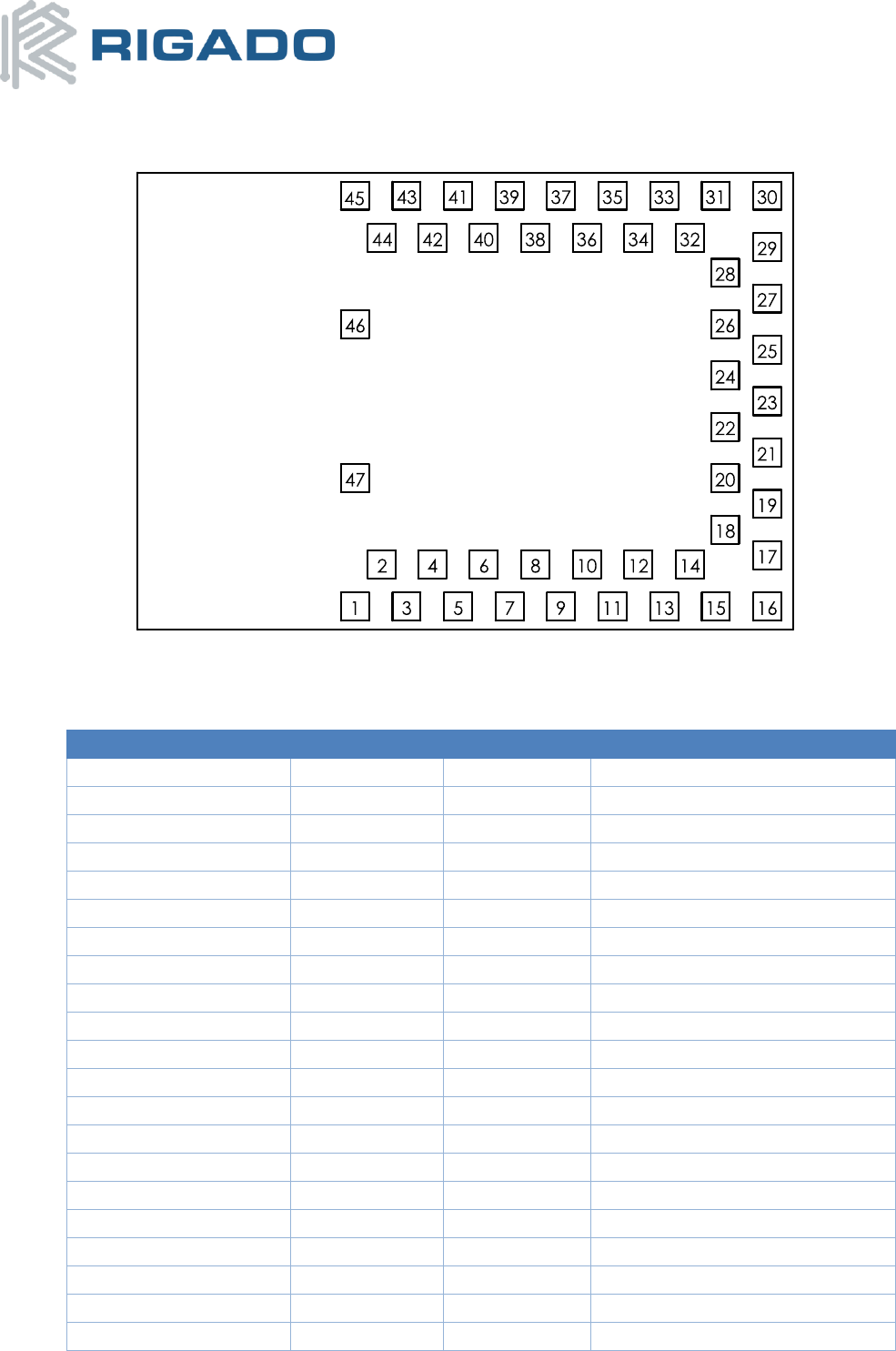
BMD-330 Module Datasheet
Bluetooth 5
September 13, 2017
BMD-330-DS V0.9 Preliminary – Subject to Change Page 5 of 24
6. Pin Descriptions
Figure 2 – BMD-330 Pin out (Top View)
Pin description
Pin Name Direction Description
6 P0.25 In/Out GPIO2
7 P0.26 In/Out GPIO2
8 P0.27 In/Out GPIO2
9 P0.28 In/Out GPIO/AIN42
10 P0.29 In/Out GPIO/AIN52
11 P0.30 In/Out GPIO/AIN62
12 P0.31 In/Out GPIO/AIN72
13 P0.00 In/Out GPIO/XTAL1 (32.768kHz)
14 P0.01 In/Out GPIO/XTAL2 (32.768kHz)
15 P0.02 In/Out GPIO/AIN0
19 P0.03 In/Out GPIO/AIN1
20 P0.04 In/Out GPIO/AIN2
21 P0.05 In/Out GPIO/AIN3
22 P0.06 In/Out GPIO
23 P0.07 In/Out GPIO
24 P0.08 In/Out GPIO
25 P0.09 In/Out GPIO
26 P0.10 In/Out GPIO
27 P0.11 In/Out GPIO
28 P0.12 In/Out GPIO
31 P0.13 In/Out GPIO
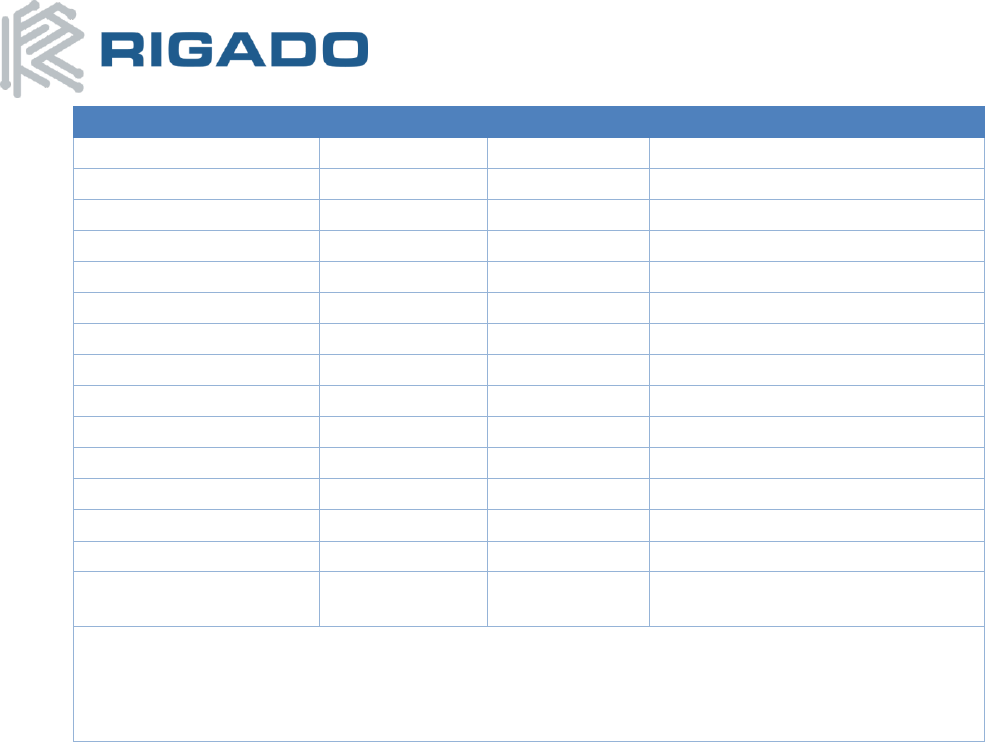
BMD-330 Module Datasheet
Bluetooth 5
September 13, 2017
BMD-330-DS V0.9 Preliminary – Subject to Change Page 6 of 24
Pin Name Direction Description
32 P0.14 In/Out GPIO
33 P0.15 In/Out GPIO
34 P0.16 In/Out GPIO
35 P0.17 In/Out GPIO
36 P0.18 In/Out GPIO
37 P0.19 In/Out GPIO
38 P0.20 In/Out GPIO
39 P0.21 In/Out GPIO/RESET
̅
̅
̅
̅
̅
̅
̅
̅
40 P0.22 In/Out GPIO2
41 P0.23 In/Out GPIO2
42 P0.24 In/Out GPIO2
43 SWCLK In SWD Clock
44 SWDIO In/Out SWD IO
17 VCC Power +1.7V to +3.6V1
1, 2, 3, 4, 5, 16, 18, 29,
30, 45, 46, 47 GND Power Electrical Ground
Note 1: An internal 4.7µF bulk capacitor is included on the module. However, it is good design practice to add additional
bulk capacitance as required for your application, i.e. those with heavy GPIO usage and/or current draw.
Note 2: These pins are in close proximity to the nRF52 radio power supply and antenna pins. Radio performance
parameters, such as sensitivity, may be affected by high frequency digital I/O with large sink/source current on these
pins. Nordic recommends using only low frequency, low-drive functions when possible.
Table 3 – BMD-330 Pin Descriptions
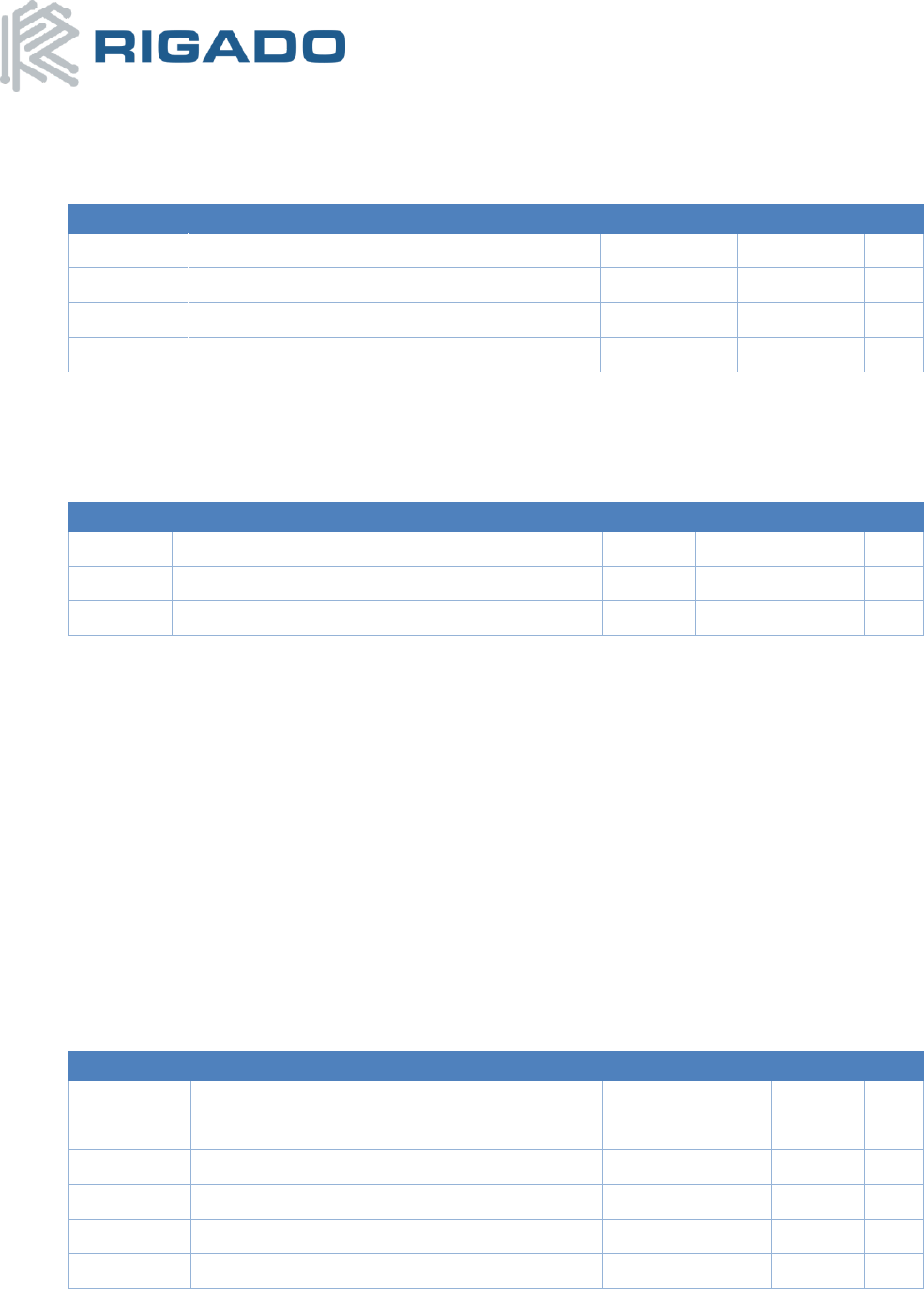
BMD-330 Module Datasheet
Bluetooth 5
September 13, 2017
BMD-330-DS V0.9 Preliminary – Subject to Change Page 7 of 24
7. Electrical Specifications
7.1 Absolute Maximum Ratings
Symbol Parameter Min. Max. Unit
VCC_MAX Voltage on supply pin -0.3 3.9 V
VIO_MAX Voltage on GPIO pins (VCC > 3.6V) -0.3 3.9 V
VIO_MAX Voltage on GPIO pins (VCC ≤ 3.6V) -0.3 VCC + 0.3V V
TS Storage Temperature Range -40 125 °C
Table 4 – Absolute Maximum Ratings
7.2 Operating Conditions
Symbol Parameter Min. Typ. Max. Unit
VCC Operating supply voltage 1.7 3.0 3.6 V
TR_VCC Supply rise time (0V to 1.7V) - - 60 ms
TA Operating Ambient Temperature Range -40 25 85 °C
Table 5 – Operating Conditions
7.3 General Purpose I/O
The general purpose I/O is organized as one port enabling access and control of the 32 available GPIO pins through
one port. Each GPIO can be accessed individually with the following user configurable features:
• Input/output direction
• Output drive strength
• Internal pull-up and pull-down resistors
• Wake-up from high or low level triggers on all pins
• Trigger interrupt on all pins
• All pins can be used by the PPI task/event system; the maximum number of pins that can be interfaced
through the PPI at the same time is limited by the number of GPIOTE channels
• All pins can be individually configured to carry serial interface or quadrature demodulator signals
Symbol Parameter Min. Typ. Max. Unit
VIH Input High Voltage 0.7 x VCC - VCC V
VIL Input Low Voltage VSS - 0.3 x VCC V
VOH Output High Voltage VCC − 0.4 - VCC V
VOL Output Low Voltage VSS - VSS + 0.4 V
RPU Pull-up Resistance 11 13 16 kΩ
RPD Pull-down Resistance 11 13 16 kΩ
Table 6 – GPIO
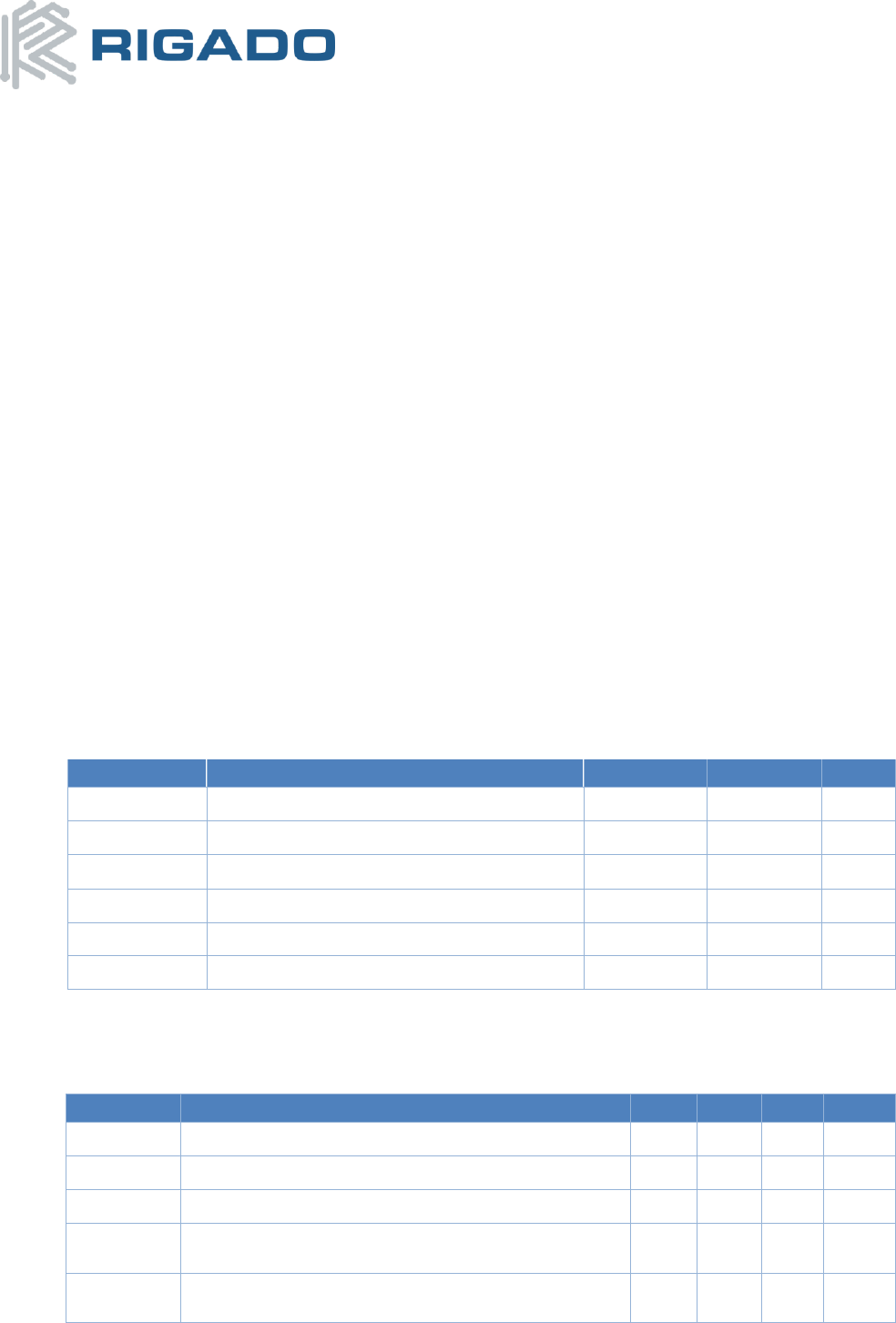
BMD-330 Module Datasheet
Bluetooth 5
September 13, 2017
BMD-330-DS V0.9 Preliminary – Subject to Change Page 8 of 24
7.4 Module RESET
GPIO pin P0.21 may be used for a hardware reset. In order to utilize P0.21 as a hardware reset, the UICR registers
PSELRESET[0] and PSELRESET[1] must be set alike, to the value of 0x7FFFFF15. When P0.21 is programmed as
RESET
̅
̅
̅
̅
̅
̅
̅
̅
, the internal pull-up is automatically enabled. Rigado and Nordic example applications and development
kits program P0.21 as RESET
̅
̅
̅
̅
̅
̅
̅
̅
.
7.5 Debug & Programming
The BMD-330 supports the two pin Serial Wire Debug (SWD) interface and offers flexible and powerful mechanism
for non-intrusive debugging of program code. Breakpoints, single stepping, and instruction trace capture of code
execution flow are part of this support.
7.6 Clocks
The BMD-330 requires two clocks, a high frequency clock and a low frequency clock.
The high frequency clock is provided on-module by a high-accuracy 32-MHz crystal as required by the
nRF52810 for radio operation.
The low frequency clock can be provided internally by an RC oscillator or synthesized from the fast clock; or
externally by a 32.768 kHz crystal. An external crystal provides the lowest power consumption and greatest
accuracy. Using the internal RC oscillator with calibration provides acceptable performance for BLE
applications at a reduced cost and slight increase in power consumption. Note: the ANT protocol requires the
use of an external crystal.
32.768 kHz Crystal (LFXO)
Symbol Parameter Typ. Max. Unit
FNOM_LFXO Crystal frequency 32.768 - kHz
FTOL_LFXO_BLE Frequency tolerance, BLE applications - ±250 ppm
CL_LFXO Load Capacitance - 12.5 pF
C0_LFXO Shunt Capacitance - 2 pF
RS_LFXO Equivalent series resistance - 100 kΩ
Cpin Input Capacitance on XL1 & XL2 pads 4 - pF
Table 7 – 32.768 kHz Crystal
32.768 kHz Oscillator Comparison
Symbol Parameter Min. Typ. Max. Unit
ILFXO Current for 32.768kHz Crystal Oscillator - 0.25 - µA
ILFRC Current for 32.768kHz RC Oscillator - 0.6 1 µA
ILFSYNT Current for 32.768kHz Synthesized Oscillator - 100 - µA
fTOL_LFXO_BLE Frequency Tolerance, 32.768kHz Crystal Oscillator
(BLE Stack)1 - - ±250 ppm
fTOL_LFXO_ANT Frequency Tolerance, 32.768kHz Crystal Oscillator
(ANT Stack)1 - - ±50 ppm
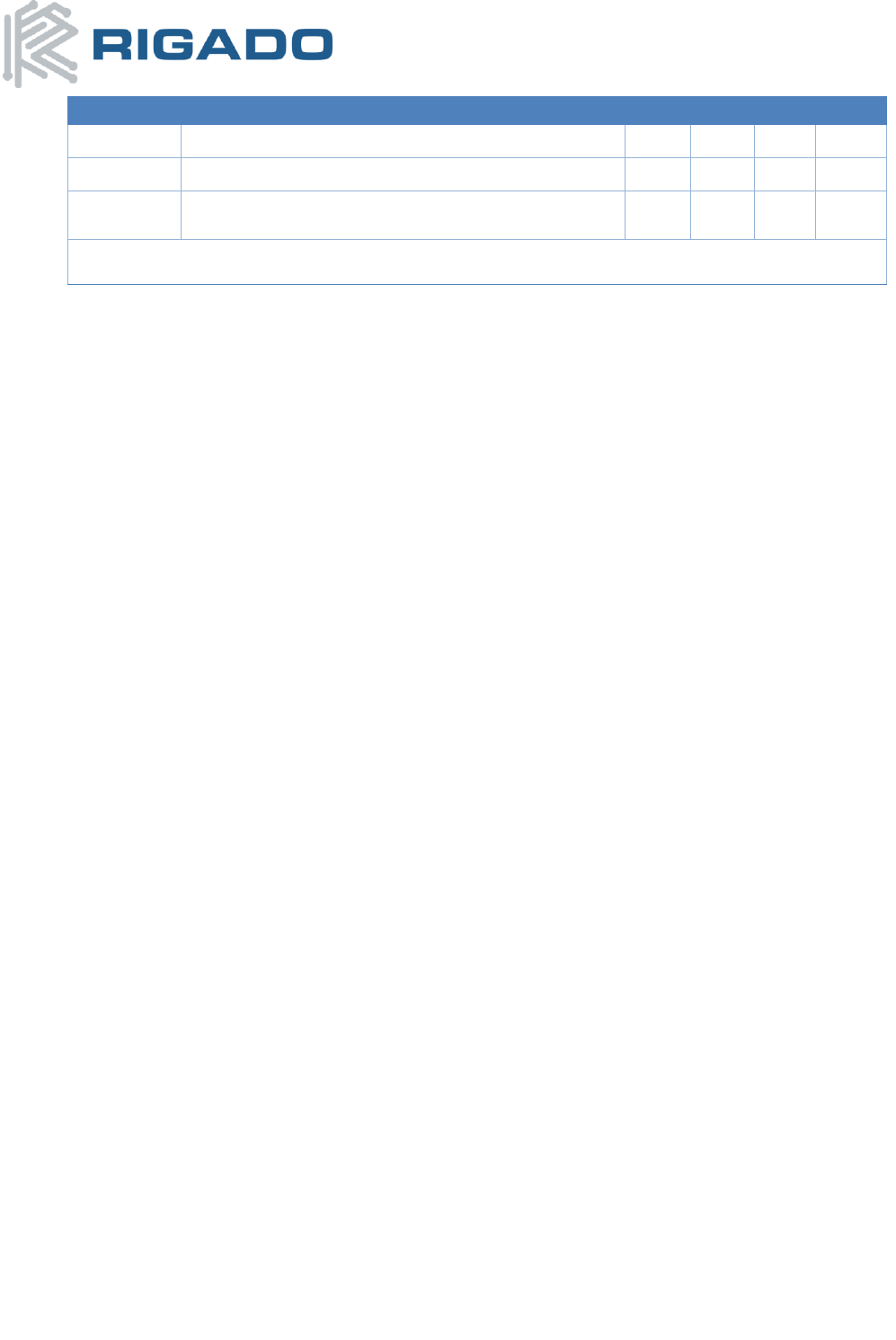
BMD-330 Module Datasheet
Bluetooth 5
September 13, 2017
BMD-330-DS V0.9 Preliminary – Subject to Change Page 9 of 24
Symbol Parameter Min. Typ. Max. Unit
f TOL_LFRC Frequency Tolerance, 32.768kHz RC Oscillator - - ±2 %
fTOL_CAL_LFRC Frequency tolerance, 32.768kHz RC after calibration - - ±250 ppm
fTOL_LFSYNT Frequency Tolerance, 32.768kHz Synthesized
Oscillator - - ±48 ppm
Note 1: fTOL_LFXO_BLE and fTOL_LFXO_ANT are the max allowed for BLE and ANT applications. Actual tolerance depends
on the crystal used.
Table 8 – 32.768 kHz Oscillator
8. Firmware
8.1 Factory Image
Due to the BMD-330’s reduced memory capacity, no factory firmware
image is provided on the module. This is indicated with a factory
version code of “00” printed on the module label. Since there is no
bootloader on the module, firmware must be loaded on the module
with the SWD interface
8.2 SoftDevices
Nordic Semiconductor protocol stacks are known as SoftDevices. SoftDevices are pre-compiled, pre-linked
binary files. SoftDevices can be programmed in nRF52 series SoCs and are downloadable from the Nordic
website. The BMD-330 with the nRF52810 SoC supports the S132 (BLE Central & Peripheral) SoftDevice.
8.2.1 S132
The S132 SoftDevice is a Bluetooth® low energy (BLE) Central and Peripheral protocol stack solution
supporting up to 20 connections with an additional Observer and a Broadcaster role all running concurrently.
The S132 SoftDevice integrates a BLE Controller and Host, and provides a full and flexible API for building
Bluetooth Smart nRF52 System on Chip (SoC) solutions.
Key Features
• Bluetooth 4.2 compliant low energy single-mode
protocol stack suitable for Bluetooth Smart products
o Concurrent central, observer, peripheral, and
broadcaster roles with up to twenty concurrent
connections along with one Observer and one
Broadcaster
o Configurable number of connections and connection
properties
o Configurable attribute table size
o Custom UUID support
o Link layer
o LL Privacy
o LE Data Packet Length Extension
o L2CAP, ATT, and SM protocols
o LE Secure Connections pairing model
o GATT and GAP APIs
o GATT Client and Server
o Configurable ATT MTU
• Complementary nRF5 SDK including Bluetooth profiles
and example applications
• Master Boot Record for over-the-air device firmware
update
o SoftDevice, application, and bootloader can be
updated separately
• Memory isolation between the application and the
protocol stack for robustness and security
• Thread-safe supervisor-call based API
• Asynchronous, event-driven behavior
• No RTOS dependency
o Any RTOS can be used
• No link-time dependencies
o Standard ARM® Cortex®-M4 project configuration
for application development
• Support for concurrent and non-concurrent
multiprotocol operation
o Concurrent with the Bluetooth stack using Radio
Timeslot API
o Alternate protocol stack in application space
• Support for control of external Power Amplifiers and
Low Noise Amplifiers

BMD-330 Module Datasheet
Bluetooth 5
September 13, 2017
BMD-330-DS V0.9 Preliminary – Subject to Change Page 10 of 24
8.3 MAC Address Info
The BMD-330 module comes preprogrammed with a unique MAC address from the factory. The MAC address
is also printed on a 2D barcode on the top of the module.
Figure 3 – BMD-300/301 MAC Address on Label
The 6-byte BLE Radio MAC address is stored in the nRF52810 UICR at NRF_UICR_BASE+0x80 LSB first. From
the factory, the MAC address can be read over SWD since read-back protection is not enabled. If performing a
full-chip-erase, the MAC can then only be recovered from the 2D barcode and human-readable text.
UICR Register:
NRF_UICR + 0x80 (0x10001080): MAC_Addr [0] (0xZZ)
NRF_UICR + 0x81 (0x10001081): MAC_Addr [1] (0xYY)
NRF_UICR + 0x82 (0x10001082): MAC_Addr [2] (0xXX)
NRF_UICR + 0x83 (0x10001083): MAC_Addr [3] (0x93)
NRF_UICR + 0x84 (0x10001084): MAC_Addr [4] (0x54)
NRF_UICR + 0x85 (0x10001085): MAC_Addr [5] (0x94)
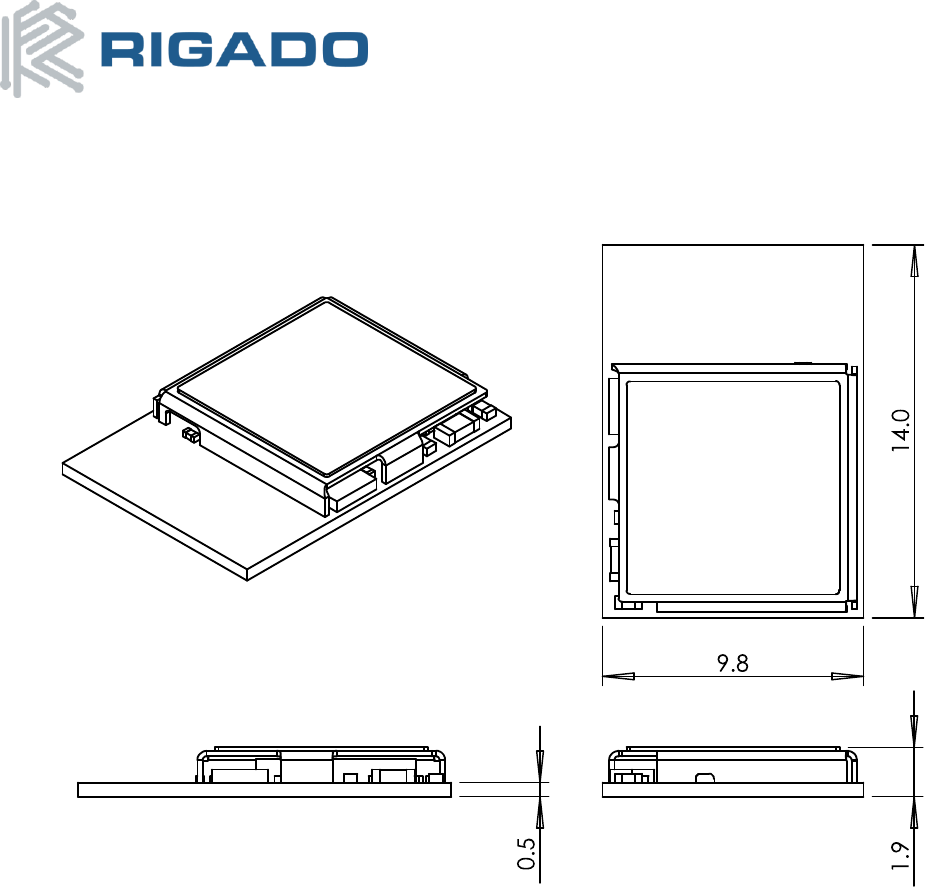
BMD-330 Module Datasheet
Bluetooth 5
September 13, 2017
BMD-330-DS V0.9 Preliminary – Subject to Change Page 11 of 24
9. Mechanical Data
9.1 Mechanical Dimensions
Figure 4 – BMD-330 Module Dimensions
(All dimensions are in mm)
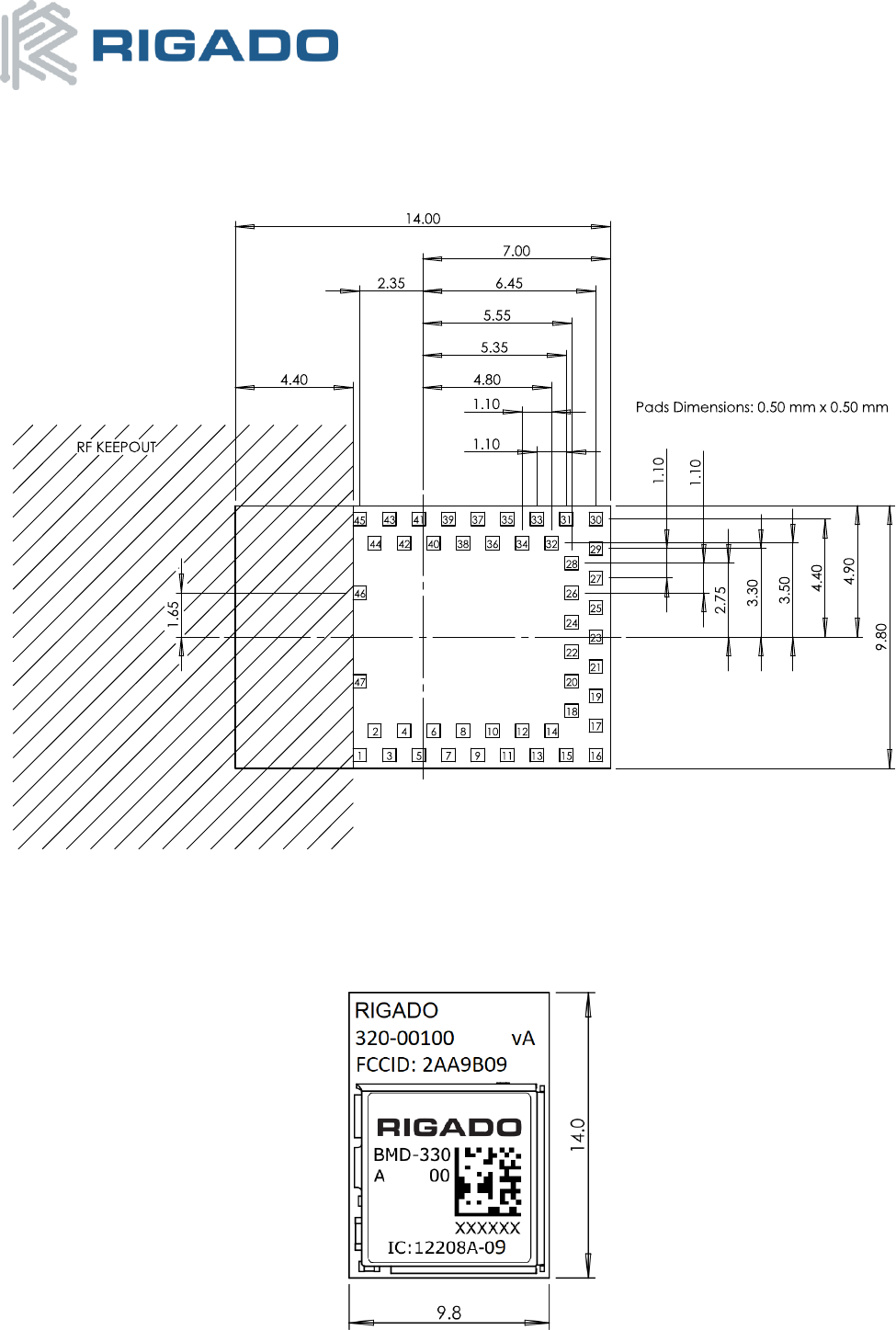
BMD-330 Module Datasheet
Bluetooth 5
September 13, 2017
BMD-330-DS V0.9 Preliminary – Subject to Change Page 12 of 24
9.2 Recommended PCB Land Pads
The BMD-330, BMD-300, and BMD-301 have identical PCB layout footprints.
Figure 5 – BMD-300/301 Dimensions (Top View)
(All dimensions are in mm)
10. Module Marking
Figure 6 – BMD-330 Module Marking – Rev A

BMD-330 Module Datasheet
Bluetooth 5
September 13, 2017
BMD-330-DS V0.9 Preliminary – Subject to Change Page 13 of 24
11. RF Design Notes
11.1 Recommended RF Layout & Ground Plane
11.1.1 BMD-300
For the BMD-330, the integrated antenna requires a suitable ground plane to radiate effectively.
The area under and extending out from the antenna portion of the module should be kept clear of copper and
other metal. The module should be placed at the edge of the PCB with the antenna edge facing out. Reducing
the ground plane from that shown in Figure 7 will reduce the effective radiated power. For example, a 27mm x
29mm board (about the size of a coin cell) has approximately 3dB lower output than the BMD-330 Evaluation
Board.
Figure 7 – BMD-300 Recommended RF Layout
11.2 Mechanical Enclosure
Care should be taken when designing and placing the module into an enclosure. Metal should be kept clear
from the antenna area, both above and below. Any metal around the module can negatively impact RF
performance.
The module is designed and tuned for the antenna and RF components to be in free air. Any potting, epoxy fill,
plastic over-molding, or conformal coating can negatively impact RF performance and must be evaluated by
the customer.
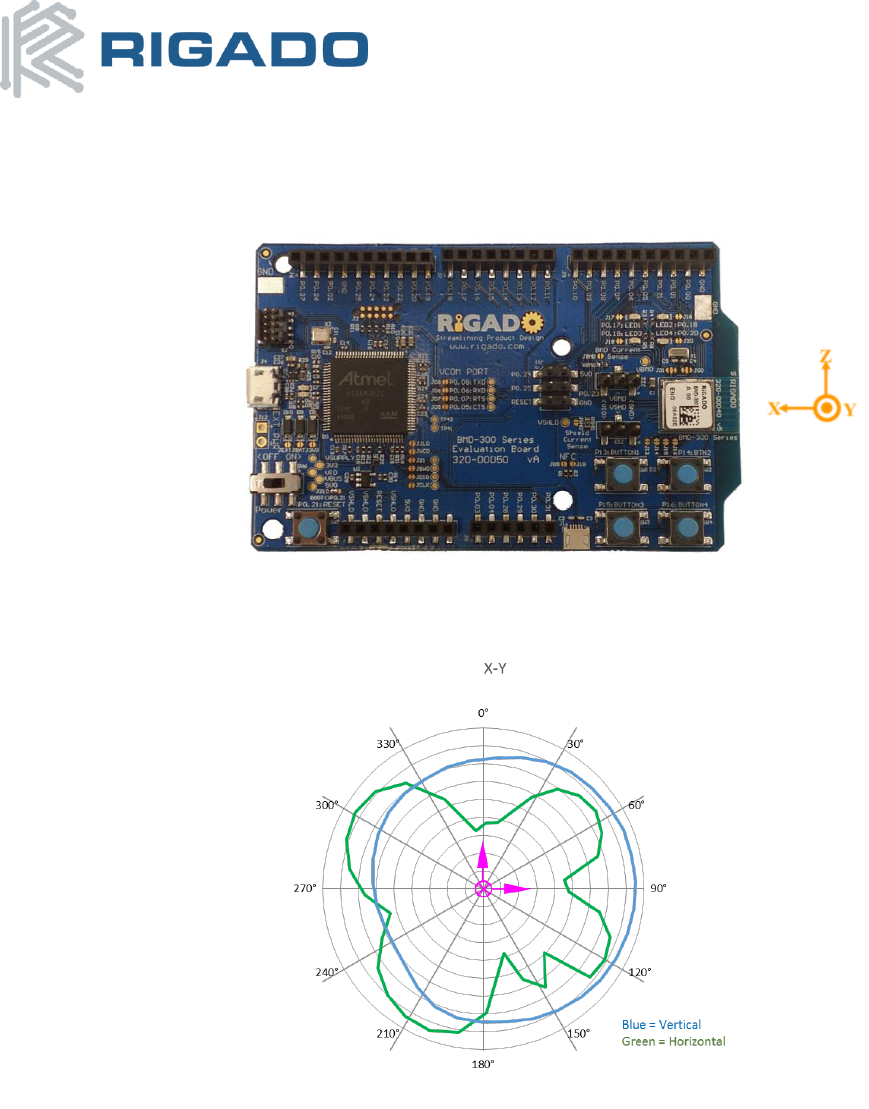
BMD-330 Module Datasheet
Bluetooth 5
September 13, 2017
BMD-330-DS V0.9 Preliminary – Subject to Change Page 14 of 24
11.3 Antenna Patterns
Antenna patterns are based on the BMD-300 Evaluation Kit vA with a ground plane size of 82mm x 56mm. The
BMD-300 module was replaced with a BMD-330 module. X-Y-Z orientation is shown in Figure 8:
Figure 8 – X-Y-Z Antenna Orientation
11.3.1.1 X-Y Plane
Figure 9 – X-Y Plane Antenna Pattern
X
Y
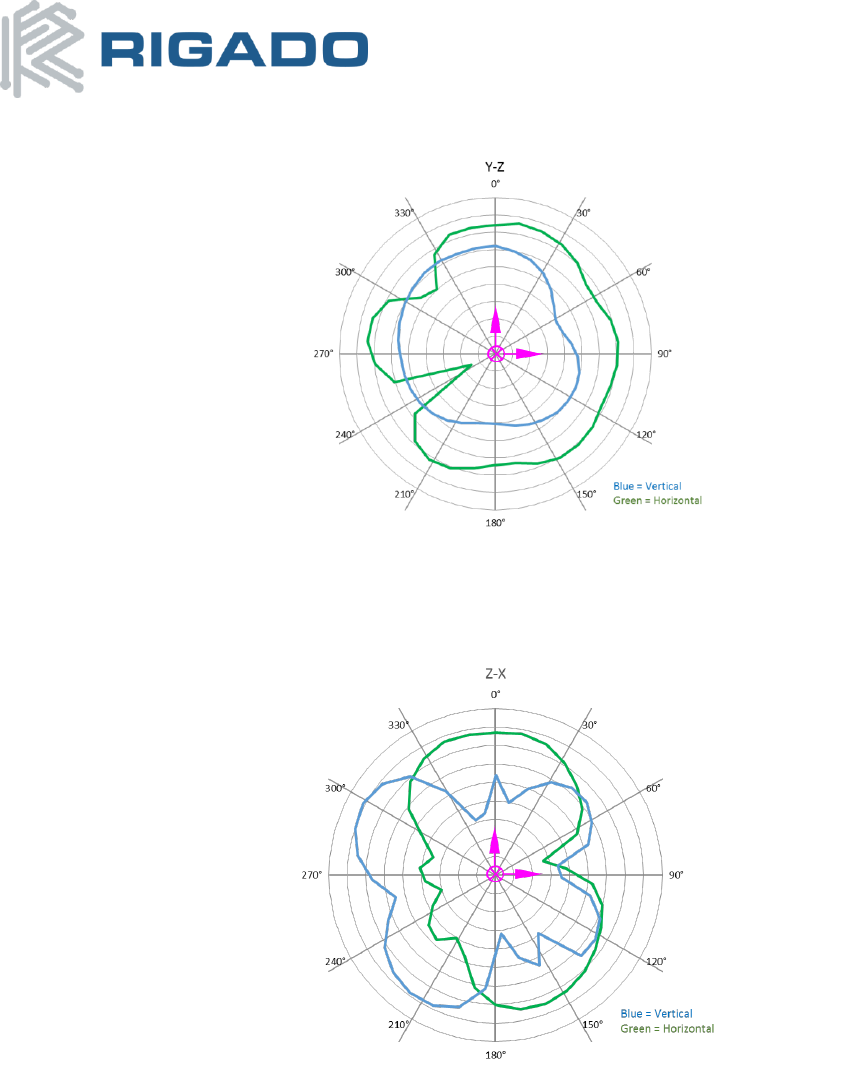
BMD-330 Module Datasheet
Bluetooth 5
September 13, 2017
BMD-330-DS V0.9 Preliminary – Subject to Change Page 15 of 24
11.3.1.2 Y-Z Plane
Figure 10 – Y-Z Plane Antenna Pattern
11.3.1.3 Z-X Plane
Figure 11 – Z-X Plane Antenna Pattern
Z
X
Y
Z

BMD-330 Module Datasheet
Bluetooth 5
September 13, 2017
BMD-330-DS V0.9 Preliminary – Subject to Change Page 16 of 24
12. Evaluation Boards
Rigado has developed full featured evaluation boards for the BMD-300 which can be used for BMD-330
development. The BMD-300 evaluation board provides a complete I/O pin out to headers, on-board
programming and debug, 32.768 kHz crystal, power & virtual COM port over USB, 4 user LEDs, and 4 user
buttons. The evaluation boards also provide the option to be powered from a CR2032 coin cell battery, and
have current sense resistors and headers to allow for convenient current measurements. An Arduino Uno R3
style header is provided for easy prototyping of additional functions. The evaluation boards also support
programming off-board BMD-300 Series modules.
13. Solution Services
Rigado is a full-service design house offering end-to-end product solution development from concept to
manufacturing. We can provide custom modules and do electrical and mechanical design, end product
manufacturing, firmware and mobile development, and web and cloud integration. Please contact Rigado at
info@rigado.com or 1-866-6-RIGADO for custom engineering options and fees.

BMD-330 Module Datasheet
Bluetooth 5
September 13, 2017
BMD-330-DS V0.9 Preliminary – Subject to Change Page 17 of 24
14. Bluetooth Qualification
The BMD-330 Series modules are qualified as a Bluetooth Component (tested) for RF-PHY (Pending). This
allows customers to use different SoftDevices that have been qualified by Nordic without the need to
complete additional RF-PHY testing. To achieve Bluetooth End Product qualification, the Rigado RF-PHY QDID
can be combined with Nordic QDIDs for the SoftDevice used when filing on the Bluetooth SIG website. The
only testing required is for the Bluetooth profiles supported by the customer’s product. Products with only
custom profiles do not require any additional testing.
• RF-PHY BT5.0 Component(Tested) Declaration ID Pending / QDID Pending
15. Regulatory Statements
Notice: All certifications are currently pending
15.1 FCC Statement:
This device has been tested and found to comply with part 15 of the FCC rules. These limits are designed to
provide reasonable protection against harmful interference in a residential installation. This equipment
generates, uses and can radiate radio frequency energy and, if not installed and used in accordance with the
instructions, may cause harmful interference to radio communications. However, there is no guarantee that
interference will not occur in a particular installation. If this equipment does cause harmful interference to
radio or television reception, which can be determined by turning the equipment off and on, the user is
encouraged to try to correct the interference by one or more of the following measures:
• Reorient or relocate the receiving antenna.
• Increase the separation between the equipment and the receiver
• Connect the equipment into an outlet on a circuit different from that to which the receiver is
connected.
• Consult the dealer or an experienced radio/TV technician for help.
Operation is subjected to the following two conditions: (1) This device may no cause harmful interference, and
(2) this device must accept any interference received, including interference that may cause undesired
operation. Note: Modification to this product will void the user’s authority to operate this equipment.
Note: Modification to this product will void the users’ authority to operate this equipment.
15.2 FCC Important Notes
(1) FCC Radiation Exposure Statement
This equipment complies with FCC RF radiation exposure limits set forth for an uncontrolled environment. This
transmitter must not be co-located or operating in conjunction with any other antenna or transmitter.
This equipment complies with Part 15 of the FCC Rules. Operation is subject the following two conditions:
(1) This device may not cause harmful interference, and
(2) This device must accept any interference received, including interference that may cause undesired
operation.
The devices must be installed and used in strict accordance with the manufacturer’s instructions as described
in this document.
Caution!
The manufacturer is not responsible for any radio or TV interference caused by unauthorized modifications to
this equipment. Such modification could void the user authority to operate the equipment.

BMD-330 Module Datasheet
Bluetooth 5
September 13, 2017
BMD-330-DS V0.9 Preliminary – Subject to Change Page 18 of 24
(2) Co-location Warning:
This device and its antenna(s) must not be co-located or operating in conjunction with any other transmitter
antenna.
(3) OEM integration instructions:
This device is intended only for OEM integrators under the following conditions:
The antenna and transmitter must not be co-located with any other transmitter or antenna. The module shall
be only used with the integral antenna(s) that has been originally tested and certified with this module.
As long as the two (2) conditions above are met, further transmitter testing will not be required. However, the
OEM integrator is still responsible for testing their end-product for any additional compliance requirements
with this module installed (for example, digital device emission, PC peripheral requirements, etc.)
In the event that these conditions cannot be met (for example certain laptop configuration or co-location with
another transmitter), then the FCC authorization for this module in combination with the host equipment is
no longer considered valid and the FCC ID of the module cannot be used on the final product. In these and
circumstance, the OEM integrator will be responsible for re-evaluating the end product (including the
transmitter) and obtaining a separate FCC authorization.
Caution!
The OEM is still responsible for verifying end product compliance with FCC Part 15, subpart B limits for
unintentional radiators through an accredited test facility.
(4) End product labeling:
The final end product must be labeled in a visible area with the following:
• “Contains FCC ID: 2AA9B09”
• Any similar wording that expresses the same meaning may be used.
The FCC Statement below should also be included on the label. When not possible, the FCC Statement should
be included in the User Manual of the host device.
“This device complies with part 15 of the FCC rules.
Operation is subject to the following two conditions. (1) This device may not cause harmful
interference. (2) This device must accept any interference received, including interference that may
cause undesired operation.”
(5) Information regarding the end user manual:
The OEM integrator has to be aware not to provide information to the end user regarding how to install or
remove this RF module in the user’s manual of the end product which integrates this module. The end user
manual shall include all required regulatory information/warning as show in this manual (Section 15.2(4)).

BMD-330 Module Datasheet
Bluetooth 5
September 13, 2017
BMD-330-DS V0.9 Preliminary – Subject to Change Page 19 of 24
15.3 IC Statement:
This device complies with Industry Canada license-exempt RSS standard(s). Operation is subject to the
following two conditions: (1) this device may not cause interference, and (2) this device must accept any
interference, including interference that may cause undesired operation of the device.
Le présent appareil est conforme aux CNR d'Industrie Canada applicables aux appareils radio exempts de
licence. L'exploitation est autorisée aux deux conditions suivantes : (1) l'appareil ne doit pas produire de
brouillage, et (2) l'utilisateur de l'appareil doit accepter tout brouillage radioélectrique subi, même si le
brouillage est susceptible d'en compromettre le fonctionnement.
RF exposure warning: The equipment complies with RF exposure limits set forth for an uncontrolled
environment. The antenna(s) used for this transmitter must not be co-located or operating in conjunction with
any other antenna or transmitter.
Avertissement d'exposition RF: L'équipement est conforme aux limites d'exposition aux RF établies pour un
incontrôlés environnement. L'antenne (s) utilisée pour ce transmetteur ne doit pas être co-localisés ou
onctionner en conjonction avec toute autre antenne ou transmetteur .
15.4 IC Important Notes
1. The OEM integrator must be aware not to provide information to the end user regarding how to install or
remove this RF module in the user manual of the end product.
The user manual which is provided by OEM integrators for end users must include the following information in
a prominent location.
2. To comply with IC RF exposure compliance requirements, the antenna used for this transmitter must not be
co‐located or operating in conjunction with any other antenna or transmitter, except in accordance with IC
multi‐transmitter product procedures.
3. The final system integrator must ensure there is no instruction provided in the user manual or customer
documentation indicating how to install or remove the transmitter module except such device has
implemented two‐ways authentication between module and the host system.
4. The host device shall be properly labelled to identify the module within the host device. The end product
must be labeled in a visible area with the following:
• “Contains IC: 12208A-09” (Pending)
Any similar wording that expresses the same meaning may be used.
The IC Statement below should also be included on the label. When not possible, the IC Statement should be
included in the User Manual of the host device.
“This device complies with Industry Canada license-exempt RSS standard(s). Operation is subject to
the following two conditions: (1) this device may not cause interference, and (2) this device must
accept any interference, including interference that may cause undesired operation of the device.
Le présent appareil est conforme aux CNR d'Industrie Canada applicables aux appareils radio exempts
de licence. L'exploitation est autorisée aux deux conditions suivantes : (1) l'appareil ne doit pas
produire de brouillage, et (2) l'utilisateur de l'appareil doit accepter tout brouillage radioélectrique
subi, même si le brouillage est susceptible d'en compromettre le onctionnement.”
A separation distance of at least 20 cm is maintained between the transmitter's radiating
structure(s) and the body of the user or nearby persons.
Une distance de séparation d'au moins 20 cm est maintenue entre l'émetteur rayonnant
structure (s) et le corps de l'utilisateur ou des personnes à proximité.

BMD-330 Module Datasheet
Bluetooth 5
September 13, 2017
BMD-330-DS V0.9 Preliminary – Subject to Change Page 20 of 24
15.5 CE Regulatory
The BMD-330 module is being tested and is expected to be compliant against the following standards. OEM
integrators should consult with qualified test house to verify all regulatory requirements have been met for
their complete device.
From Directive 2006/95/EC:
• EN 60950-1: 2006 + A11: 2009 + A1: 2010 + A12: 2011
From R&TTE Directive 1999/5/EC:
• ETSI EN 300 328 V 2.1.1
From Directive 2004/108/EC:
• ETSI EN 301 489-1 V2.1.1
• ETSI EN 301 489-17 V3.1.1
Declarations of Conformity and supporting test reports are available at www.rigado.com.
15.6 Australia / New Zealand
The BMD-330 module has been tested to comply with the AS/NZS 4268 :2012+AMDT 1:2013, Radio
equipment and systems – Short range devices – Limits and methods of measurement. The report may be
downloaded from www.rigado.com, and may be used as evidence in obtaining permission to use the RCM.
Information on registration as a Responsible Party, license and labeling requirements may be found at the
following websites:
Australia: http://www.acma.gov.au/theACMA/radiocommunications-short-range-devices-standard-2004
New Zealand: http://www.rsm.govt.nz/compliance
The A-Tick and C-Tick marks are being migrated to the Regulatory Compliance Mark (RCM). Only Australian-
based and New Zealand-based companies who are registered may be granted permission to use the RCM. An
Australian-based or New Zealand-based agent or importer may also register as a Responsible Party to use the
RCM on behalf of a company not in Australia or New Zealand.

BMD-330 Module Datasheet
Bluetooth 5
September 13, 2017
BMD-330-DS V0.9 Preliminary – Subject to Change Page 21 of 24
16. Solder Reflow Temperature-Time Profile
Figure 12 – Reflow Profile for Lead Free Solder
16.1 Moisture Sensitivity Level
The BMD-330 is rated for MSL 3, 168-hour floor life after opening.
17. Packaging and Labeling
17.1 Carrier Tape Dimensions
Figure 13 – BMD-330 Carrier Tape Dimensions
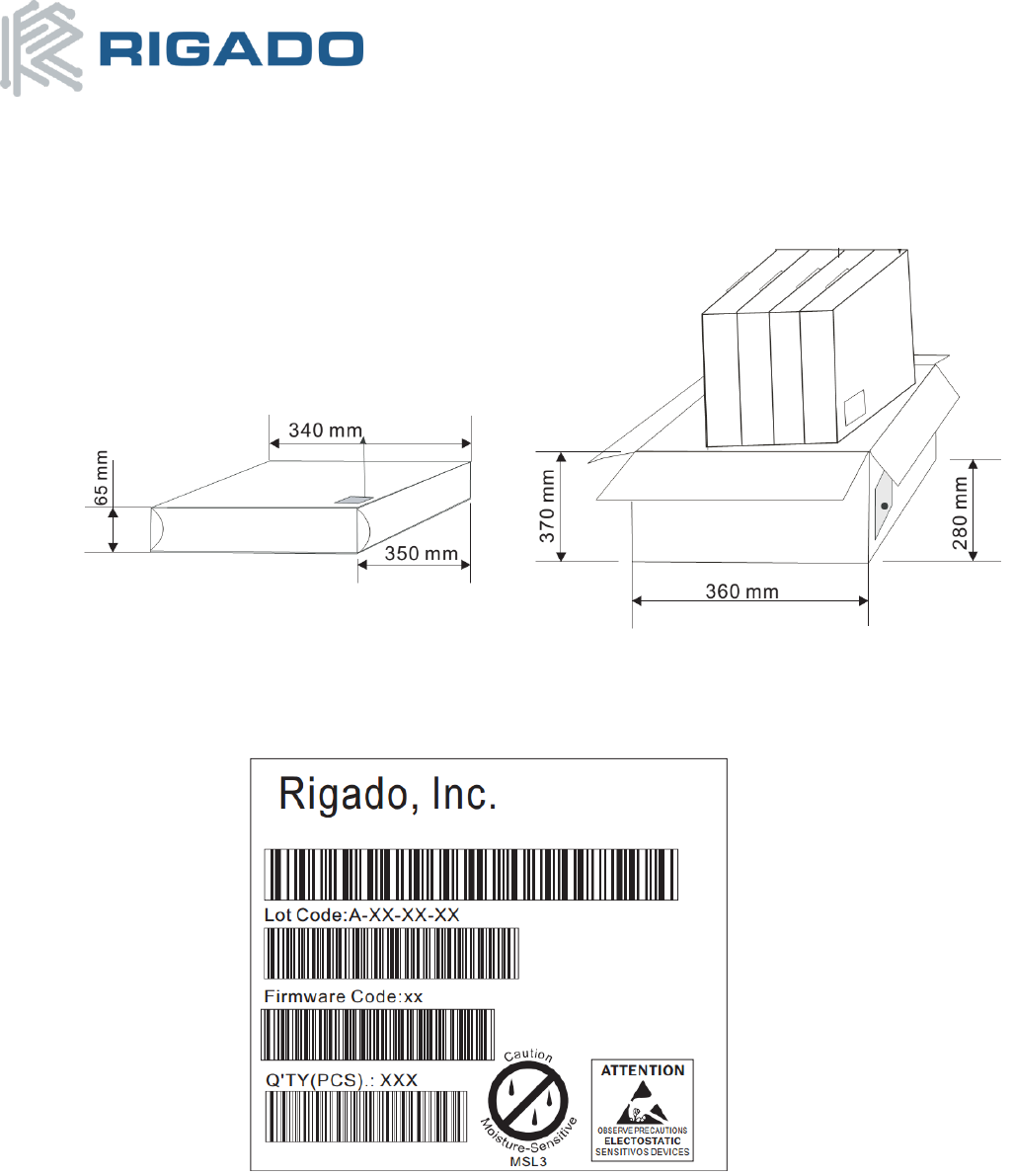
BMD-330 Module Datasheet
Bluetooth 5
September 13, 2017
BMD-330-DS V0.9 Preliminary – Subject to Change Page 22 of 24
17.2 Reel Packaging
Modules come on 330mm reels loaded with 1000 modules. Each reel is placed in an antistatic bag with a
desiccant pack and humidity card and placed in a 340x350x65mm box. On the outside of the bag an
antistatic warning and reel label are adhered.
Figure 14 – Reel Cartons
17.3 Packaging Label
Figure 15 – Packaging Label
Part No.: BMD-330-A-R

BMD-330 Module Datasheet
Bluetooth 5
September 13, 2017
BMD-330-DS V0.9 Preliminary – Subject to Change Page 23 of 24
18. Cautions
1) The guidelines of this document should be followed in order to assure proper performance of the module.
2) This product is for use in office, business, and residential applications, but not medical devices.
3) This module may short-circuit. If a short circuit can result in serious damage or injury then failsafe
precautions should be used. This could be accomplished by redundant systems and protection circuits.
4) Supply voltage to the module should not be higher than the specified inputs or reversed. Additionally, it
should not contain noise, spikes, or AC ripple voltage.
5) Avoid use with other high frequency circuits.
6) Use methods to eliminate static electricity when working with the module as it can damage the
components.
7) Contact with wires, the enclosure, or any other objects should be avoided.
8) Refer to the recommended pattern when designing for this module.
9) If hand soldering is used, be sure to use the precautions outlined in this document.
10) This module should be kept away from heat, both during storage and after installation.
11) Do not drop or physically shock the module.
12) Do not damage the interface surfaces of the module.
13) The module should not be mechanically stressed at any time (storage, handling, installation).
14) Do not store or expose this module to:
• Humid or salty air conditions
• High concentrations of corrosive gasses.
• Long durations of direct sunlight.
• Temperatures lower than -40°C or higher than 125°C.
19. Life Support Policy
This product is not designed to be used in a life support device or system, or in applications where there is potential
for a failure or malfunction to, directly or indirectly, cause significant injury. By using this product in an application
that poses these risks, such as described above, the customer is agreeing to indemnify Rigado for any damages that
result.

BMD-330 Module Datasheet
Bluetooth 5
September 13, 2017
BMD-330-DS V0.9 Preliminary – Subject to Change Page 24 of 24
20. Document History
Revision Date Changes / Notes
0.9 09/13/2017 Preliminary release
21. Related Documents
Rigado Documents:
• BMD-300-Series-EVAL-UG: Evaluation Kit User Guide
• BMD-300 Series Data Sheet
Nordic Documents:
Visit infocenter.nordicsemi.com for a comprehensive library of Nordic technical documentation.
• nRF52810 – nRF52810 Product Specification
• S132-SDS – nRF52832 S132 Soft Device Specification
FCC Statement
This device complies with part 15 of the FCC Rules. Operation is subject to the following two
conditions:
(1) This device may not cause harmful interference, and
(2) this device must accept
any interference received, including interference that may cause undesired operation.
Any Changes or modifications not expressly approved by the party responsible for compliance
could void the user's authority to operate the equipment.
The modular can be installed or integrated in mobile or fix devices only. This modular cannot be
installed in any portable device.
FCC Radiation Exposure Statement
This modular complies with FCC RF radiation exposure limits set forth for an uncontrolled
environment. This transmitter must not be co-located or operating in conjunction with any other
antenna or transmitter. This modular must be installed and operated with a minimum distance
of 20 cm between the radiator and user body.
If the FCC identification number is not visible when the module is installed inside another device,
then the outside of the device into which the module is installed must also display a label
referring to the enclosed module. This exterior label can use wording such as the following:
“Contains Transmitter Module FCC ID: 2AA9B09 Or ContainsFCC ID: 2AA9B09”
When the module is installed inside another device, the user manual of the host must contain
below warning statements;
1. This device complies with Part 15 of the FCC Rules. Operation is subject to the following two
conditions:
(1) This device may not cause harmful interference.
(2) This device must accept any interference received, including interference that may cause
undesired operation.
2. Changes or modifications not expressly approved by the party responsible for compliance
could void the user's authority to operate the equipment.
The devices must be installed and used in strict accordance with the manufacturer's instructions
as described in the user documentation that comes with the product.
Any company of the host device which install this modular with Single modular approval should
perform the test of radiated emission and spurious emission according to FCC part 15C : 15.247
requirement, Only if the test result comply with FCC part 15C : 15.247 requirement, then the
host can be sold legally.
IC statement
This device complies with Industry Canada’s licence-exempt RSSs. Operation is subject to the
following two conditions:
(1) This device may not cause interference; and
(2) This device must accept any interference, including interference that may cause undesired
operation of the device.
Cet appareil est conforme aux CNR exemptes de licence d'Industrie Canada . Son fonctionnement
est soumis aux deux conditions suivantes :
( 1 ) Ce dispositif ne peut causer d'interférences ; etc
( 2 ) Ce dispositif doit accepter toute interférence , y compris les interférences qui peuvent
causer un mauvais fonctionnement de l'appareil.
A separation distance of at least 20 cm is maintained between the transmitter's radiating
structure(s) and the body of the user or nearby persons.
Une distance de séparation d'au moins 20 cm est maintenue entre l'émetteur rayonnant
structure (s) et le corps de l'utilisateur ou des personnes à proximité.
For a host manufacture's using a certified modular, if (1) the module's IC number is not visible
when installed in the host, or (2) if the host is marketed so that end users do not have
straightforward commonly used methods for access to remove the module so that the IC number
of the module is visible; then an additional permanent label referring to the enclosed module:
"Contains Transmitter Module IC: " 12208A-09 " or "Contains IC: 12208A-09" must be used.